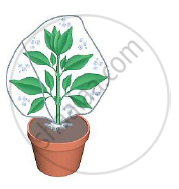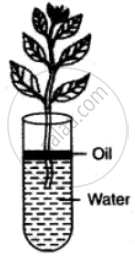Advertisements
Advertisements
प्रश्न
Suppose you have a small rose plant growing in a pot. How would you demonstrate transpiration in it?
उत्तर
Take the small potted rose plant and cover it with a transparent polythene bag. Tie its mouth around the base of the stem. Leave the plant in sunlight for an hour or two.

Drops of water will soon appear on the inner side of the bag due to the saturation of water vapour given out by the leaves. A similar empty polythene bag with its mouth tied and kept in sunlight will show no drops of water. This is the control to show that plants transpire water in the form of water. If tested with dry cobalt chloride paper, the drops will be confirmed as water only.
APPEARS IN
संबंधित प्रश्न
Which of the following statements are true and which ones are false? Give reason in support of your answer.
Most transpiration occurs during midday.
Choose the correct answer:
In herbaceous plants, following percentage of absorbed water comes out __________
Briefly explain how the rate of transpiration is affected by:
Humidity of the atmosphere
What are lenticels? Where are they found?
What are the disadvantages of transpiration?
Explain the Term
Lenticular
Differentiate Between Cuticular and Lenticular transpiration.
Study the diagram given below and answer the questions that follow:

(i) Name the process being studied in the above experiment.
(ii) Explain the process mentioned in (i) above.
(iii) Why is oil placed over water?
The following diagram is set up to demonstrate an experiment.
 Five plants A, B, C, D, and E were placed in a beaker containing water. The water in each beaker was covered with a layer of oil. The leaves were removed from plant D in plant B, upper surfaces of all the leaves were covered with Vaseline, in-plant C the lower surfaces of all the leaves were covered with Vaseline and plant E was exposed to strong light. The beakers were then left for a few hours and at the end of the experimental period, weights of each beaker were taken.
Five plants A, B, C, D, and E were placed in a beaker containing water. The water in each beaker was covered with a layer of oil. The leaves were removed from plant D in plant B, upper surfaces of all the leaves were covered with Vaseline, in-plant C the lower surfaces of all the leaves were covered with Vaseline and plant E was exposed to strong light. The beakers were then left for a few hours and at the end of the experimental period, weights of each beaker were taken.
Write the correct answer out of the five available choices given under each question:
I. In which beaker would you expect the greatest decrease in weight?
(i) A (ii) B (iii) C (iv) D (v) E
II. In which beaker the change of weight would be minimum?
(i) A (ii) B (iii) C (iv) D (v) E
III. Which plant would remain healthy for a longer period of time?
(i) A (ii) B (iii) C (iv) D (v) E
IV. In this experiment which plant can be considered as the uncontrolled one?
(I) A (ii) B (iii) C (iv) D (v) E
V. The difference of weight would b maximum between:
(i) A and B (ii) A and C (iii) A and D (iv) A and E (v) D and E
Name the following:
Plants in which lenticular transpiration.
